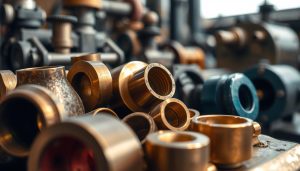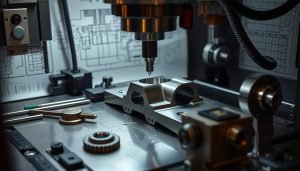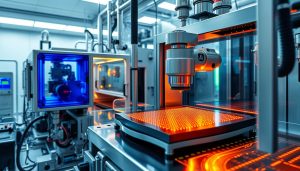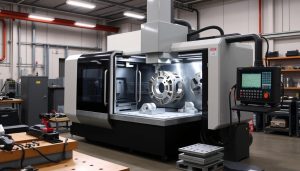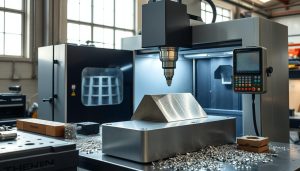In the ever-evolving world of manufacturing, the debate surrounding the role of 3D printing and CNC machining in rapid prototyping has been a captivating topic. As these two distinct technologies continue to advance, it’s crucial to explore their respective strengths, limitations, and potential future impact on the industry.
Rapid prototyping has long been a crucial step in the product development process, allowing designers and engineers to quickly create and test physical models before committing to full-scale production. Both 3D printing and CNC machining have carved out their own niches in this domain, each offering unique advantages that have shaped the way we approach prototype creation.
As we delve deeper into the nuances of these manufacturing technologies, we’ll uncover the factors that influence their suitability for various rapid prototyping scenarios. From the flexibility of 3D printing to the precision and durability of CNC machining, we’ll explore the tradeoffs and consider whether one technology might ultimately supplant the other in the race to bring innovative products to market.
Understanding 3D Printing and CNC Machining
In the realm of rapid prototyping, two distinct manufacturing technologies have emerged as key players: additive manufacturing (3D printing) and subtractive manufacturing (CNC machining). Understanding the fundamental differences between these processes is crucial in determining the most suitable approach for your prototyping needs.
What is 3D Printing?
Additive manufacturing, commonly known as 3D printing, is a process that creates three-dimensional objects by building them up layer by layer. This digital fabrication technique allows designers and engineers to transform digital models into physical prototypes, often with intricate designs and complex geometries. 3D printing has become a popular choice for rapid prototyping due to its flexibility and ability to produce customized parts efficiently.
What is CNC Machining?
Subtractive manufacturing, or CNC (Computer Numerical Control) machining, is a process that removes material from a solid block or workpiece to create the desired shape. This highly precise technique utilizes computer-controlled tools to carve out parts, often resulting in prototypes with exceptional accuracy and surface finish. CNC machining is well-suited for producing functional prototypes that require specific material properties and dimensional tolerances.
| Feature | 3D Printing | CNC Machining |
|---|---|---|
| Manufacturing Process | Additive | Subtractive |
| Material Choices | Polymers, metals, ceramics | Metals, plastics, composites |
| Geometric Complexity | High | Moderate |
| Precision and Accuracy | Moderate | High |
| Lead Time | Faster | Slower |
By understanding the distinct characteristics of 3D printing and CNC machining, manufacturers can make informed decisions on the most appropriate prototyping techniques for their specific project requirements, whether it be additive manufacturing, subtractive manufacturing, or a combination of both prototyping techniques.
Key Differences Between 3D Printing and CNC Machining
When it comes to rapid prototyping, understanding the key differences between 3D printing and CNC machining is crucial. These two manufacturing techniques offer distinct advantages and drawbacks that can significantly impact the prototyping process and the final product.
Speed and Efficiency in Prototyping
3D printing is often touted for its speed and efficiency in producing initial prototypes. The additive nature of 3D printing allows for the creation of complex geometric shapes without the need for elaborate tooling or setup time. This makes 3D printing an attractive option for rapid iterations and quick-turnaround prototypes. On the other hand, CNC machining excels in producing high-quality, functional prototypes at scale, leveraging its subtractive manufacturing approach to achieve exceptional manufacturing efficiency.
Material Choices and Strength Considerations
The range of material properties available for 3D printing is constantly expanding, allowing designers to experiment with a variety of materials, from plastics to metals. However, the strength and durability of 3D-printed parts can sometimes be a concern, particularly for functional prototypes. CNC machining, on the other hand, offers a wider selection of engineering-grade materials, including metals and high-performance plastics, ensuring the prototype accuracy and long-term reliability of the final product.
Precision and Accuracy: CNC vs 3D Printing
CNC machining is renowned for its exceptional precision and accuracy, with the ability to produce intricate details and tight tolerances. This makes CNC machining the preferred choice for prototypes that require high-level precision and quality control. 3D printing, while continuously improving in terms of resolution and accuracy, may still face limitations in achieving the same level of precision as CNC machining, especially for certain applications.
“The choice between 3D printing and CNC machining for rapid prototyping often comes down to the specific requirements of the project, balancing factors like speed, material properties, and precision.”
Advantages of 3D Printing in Rapid Prototyping
While CNC machining remains a trusted method for producing high-precision prototypes, 3D printing boasts several unique advantages that make it an increasingly attractive option for rapid prototyping. From its unparalleled flexibility in design and geometrical complexity to its speed in producing initial prototypes and cost-effectiveness for low-volume manufacturing, 3D printing is carving out a significant role in the world of rapid prototyping.
Flexibility in Design and Geometrical Complexity
One of the standout benefits of 3D printing is its ability to seamlessly translate complex geometries into physical prototypes. Unlike traditional manufacturing methods, 3D printing allows designers to explore intricate, organic shapes and unique design elements without the constraints of conventional tooling. This newfound freedom opens up a world of creative possibilities, enabling rapid iteration and the realization of truly innovative product concepts.
Speed in Producing Initial Prototypes
In the fast-paced world of product development, speed is of the essence. 3D printing excels in this regard, offering drastically reduced turnaround times for initial prototypes compared to CNC machining. With the ability to produce a physical model within hours or days, 3D printing empowers teams to quickly validate their designs, gather feedback, and make necessary adjustments, accelerating the overall prototyping process.
Cost-Effective for Low-Volume Production
For companies focused on low-volume manufacturing or producing small batches of products, 3D printing can be a highly cost-effective solution. The additive nature of 3D printing eliminates the need for expensive tooling, molds, and setups required in traditional manufacturing. This makes 3D printing an attractive option for companies exploring complex geometries, rapid iteration, and low-volume manufacturing strategies.

“3D printing has revolutionized the way we approach product development, offering unparalleled design freedom and accelerating the prototyping process.”
As the technology continues to evolve and become more accessible, the advantages of 3D printing in rapid prototyping are becoming increasingly compelling for a wide range of industries. By embracing this innovative approach, companies can unlock new possibilities in their product development journey, driving innovation and staying ahead of the competition.
Advantages of CNC Machining in Rapid Prototyping
While 3D printing has become a popular choice for rapid prototyping, CNC machining remains a powerful tool that offers distinct advantages. Its precision, material versatility, and ability to create long-lasting, functional prototypes make it an essential part of the prototyping process.
High Precision and Quality Control
CNC machining excels at producing parts with exceptional precision and tight tolerances. This level of accuracy is crucial for components that require a perfect fit or complex geometries. The rigorous quality control measures inherent in CNC machining ensure a consistently high-quality output, making it a preferred choice for precision machining.
Ability to Work with Tougher Materials
CNC machining can handle a wide range of materials, including metals, plastics, and composites, that may be difficult or impossible to print using 3D printing technology. This material versatility allows for the creation of durable prototypes that can withstand rigorous functional testing.
Long-Term Durability and Functional Prototypes
The parts produced through CNC machining are often more durable and long-lasting compared to their 3D-printed counterparts. This makes CNC machining the preferred choice for creating functional prototypes that need to be tested and evaluated over an extended period of time.

“CNC machining is the go-to choice when you need highly precise, durable, and functional prototypes that can withstand rigorous testing.”
By leveraging the strengths of CNC machining, companies can create precision parts, durable prototypes, and functional testing setups that are essential for successful product development and innovation.
Can 3D Printing Fully Replace CNC Machining?
The debate over whether 3D printing can fully replace CNC machining in rapid prototyping is an ongoing discussion. While both technologies offer unique advantages, the answer lies in understanding the specific situations where each excels.
Situations Where 3D Printing is a Better Fit
3D printing shines when it comes to creating complex geometries and intricate designs. Its ability to produce parts with advanced features, such as internal channels or organic shapes, makes it a preferred choice for rapid prototyping of innovative products. Additionally, 3D printing is often more cost-effective for low-volume production runs, as it eliminates the need for expensive tooling or fixturing required in traditional CNC machining.
Situations Where CNC Machining is Essential
However, CNC machining remains essential for prototypes that require exceptional precision, strength, and durability. Parts that need to withstand high-stress loads or be made from tough materials, such as metal or advanced composites, are often better suited for CNC machining. This process also offers superior surface finishes and tighter tolerances, making it the go-to choice for producing functional prototypes that closely mimic the final product.
The future of rapid prototyping lies in a hybrid approach, where 3D printing and CNC machining are used as complementary technologies to leverage their respective strengths. This hybrid manufacturing approach allows companies to combine the flexibility and design freedom of 3D printing with the precision and material capabilities of CNC machining, resulting in the most efficient and cost-effective prototyping solutions for a wide range of industry-specific applications.
| Criteria | 3D Printing | CNC Machining |
|---|---|---|
| Geometrical Complexity | High | Moderate |
| Material Choices | Diverse (plastics, resins, metals) | Extensive (metals, composites, wood) |
| Precision and Accuracy | Moderate | High |
| Functional Prototyping | Limited | Excellent |
| Cost-Effectiveness for Low Volumes | High | Moderate |
In summary, while 3D printing and CNC machining each have their own strengths, the future of rapid prototyping lies in a hybrid manufacturing approach that combines these complementary technologies to deliver the most optimal solutions for a wide range of industry-specific applications.
Shixinproto’s Services for Rapid Prototyping
At Shixinproto, we understand that rapid prototyping is essential for bringing innovative products to market. That’s why we offer a comprehensive suite of services that seamlessly integrate the strengths of both 3D printing and CNC machining to deliver optimal results for our clients.
Expertise in Combining CNC Machining and 3D Printing for Optimal Results
Our team of skilled engineers and technicians possess deep expertise in selecting the most appropriate manufacturing technology for each project’s unique requirements. By leveraging the flexibility of 3D printing and the precision of CNC machining, we can create high-quality prototypes that meet your exact specifications, whether you need parts with intricate geometries or robust functional components.
Through our integrated prototyping approach, we can provide you with custom manufacturing solutions tailored to your needs. From rapid 3D printed models for initial concept validation to durable CNC-machined parts for functional testing, we have the capabilities to guide you through every stage of the product development cycle.
